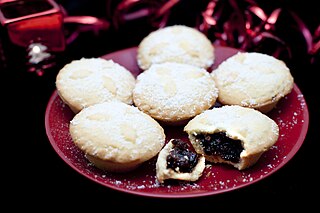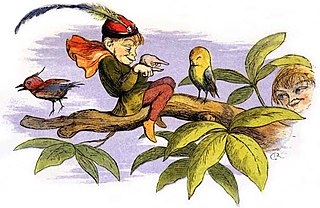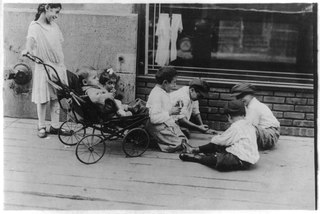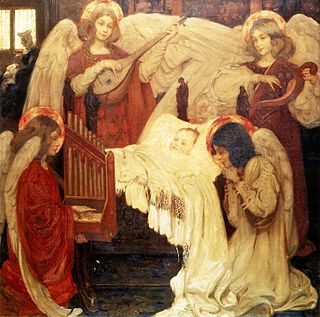Related Research Articles

A nursery rhyme is a traditional poem or song for children in Britain and many other countries, but usage of the term dates only from the late 18th/early 19th century. The term Mother Goose rhymes is interchangeable with nursery rhymes.

A mince pie is a sweet pie of English origin filled with mincemeat, a mixture of fruit and spices. It is traditionally served during the Christmas season in much of the English-speaking world. Its ingredients are traceable to the 13th century, when returning European crusaders brought with them Middle Eastern recipes containing meats, fruits, and spices; these contained the Christian symbolism of representing the gifts delivered to Jesus by the Biblical Magi. Mince pies, at Christmastide, were traditionally shaped in an oblong shape, to resemble a manger and were often topped with a depiction of the Christ Child.
"Eeny, meeny, miny, moe"—which can be spelled a number of ways—is a children's counting-out rhyme, used to select a person in games such as tag, or for selecting various other things. It is one of a large group of similar rhymes in which the child who is pointed to by the chanter on the last syllable is chosen. The rhyme has existed in various forms since well before 1820 and is common in many languages using similar-sounding nonsense syllables. Some versions use a racial epithet, which has made the rhyme controversial at times.

John Aubrey was an English antiquary, natural philosopher and writer. He is perhaps best known as the author of the Brief Lives, his collection of short biographical pieces. He was a pioneer archaeologist, who recorded numerous megalithic and other field monuments in southern England, and who is particularly noted for his systematic examination of the Avebury henge monument. The Aubrey holes at Stonehenge are named after him, although there is considerable doubt as to whether the holes that he observed are those that currently bear the name. He was also a pioneer folklorist, collecting together a miscellany of material on customs, traditions and beliefs under the title "Remaines of Gentilisme and Judaisme". He set out to compile county histories of both Wiltshire and Surrey, although both projects remained unfinished. His "Interpretation of Villare Anglicanum" was the first attempt to compile a full-length study of English place-names. He had wider interests in applied mathematics and astronomy, and was friendly with many of the greatest scientists of the day.

English folklore consists of the myths and legends of England, including the English region's mythical creatures, traditional recipes, urban legends, proverbs, superstitions, and folktales. Its cultural history is rooted in Celtic, Christian, and Germanic folklore.

A fairy ring, also known as fairy circle, elf circle, elf ring or pixie ring, is a naturally occurring ring or arc of mushrooms. They are found mainly in forested areas, but also appear in grasslands or rangelands. Fairy rings are detectable by sporocarps in rings or arcs, as well as by a necrotic zone, or a ring of dark green grass. Fungus mycelium is present in the ring or arc underneath. The rings may grow to over 10 metres (33 ft) in diameter, and they become stable over time as the fungus grows and seeks food underground.

"London Bridge Is Falling Down" is a traditional English nursery rhyme and singing game, which is found in different versions all over the world. It deals with the dilapidation of London Bridge and attempts, realistic or fanciful, to repair it. It may date back to bridge-related rhymes and games of the Late Middle Ages, but the earliest records of the rhyme in English are from the 17th century. The lyrics were first printed in close to their modern form in the mid-18th century and became popular, particularly in Britain and the United States, during the 19th century.

A singing game is an activity based on a particular verse or rhyme, usually associated with a set of actions and movements. As a collection, they have been studied by folklorists, ethnologists, and psychologists and are seen as important part of childhood culture. The same term is also used for a form of video game that involves singing.

Wise Men of Gotham is the early name given to the people of the village of Gotham, Nottinghamshire, in allusion to an incident where they supposedly feigned idiocy to avoid a Royal visit.

A children's song may be a nursery rhyme set to music, a song that children invent and share among themselves or a modern creation intended for entertainment, use in the home or education. Although children's songs have been recorded and studied in some cultures more than others, they appear to be universal in human society.
"Tinker, Tailor" is a counting game, nursery rhyme and fortune telling song traditionally played in England, that can be used to count cherry stones, buttons, daisy petals and other items. It has a Roud Folk Song Index number of 802. It is commonly used by children in both Britain and America for "counting out", e.g. for choosing who shall be "It" in a game of tag.
John Brand was an English antiquarian and Church of England clergyman. He was author of Observations on Popular Antiquities: including the whole of Mr Bourne's “Antiquitates Vulgares,” with addenda to every chapter of that work.

"Monday's Child" is one of many fortune-telling songs, popular as nursery rhymes for children. It is supposed to tell a child's character or future from his or her day of birth and to help young children remember the seven days of the week. As with all nursery rhymes, there are many versions. It has a Roud Folk Song Index number of 19526.

Childlore is the folklore or folk culture of children and young people. It includes, for example, rhymes and games played in the school playground. The best known researchers of the field were Iona and Peter Opie.

Tom Hickathrift is a legendary figure of East Anglian English folklore — a character similar to Jack the Giant Killer. He famously battled a giant, and is sometimes said to be a giant himself, though normally he is just represented as possessing giant-like strength.

A soul cake, also known as a soulmass-cake, is a small round cake which is traditionally made for Halloween, All Saints' Day and All Souls' Day to commemorate the dead in many Christian traditions. The cakes, often simply referred to as souls, are given out to soulers who go from door to door during the days of Allhallowtide singing and saying prayers "for the souls of the givers and their friends". The practice in England dates to the medieval period, and was continued there until the 1930s. In Sheffield and Cheshire, the custom has continued into modern times. In Lancashire and in the North-east of England soul cakes were known as Harcakes, a kind of thin parkin.

"One for Sorrow" is a traditional children's nursery rhyme about magpies. According to an old superstition, the number of magpies seen tells if one will have bad or good luck.

"Matthew, Mark, Luke and John", also known as the "Black Paternoster", is an English children's bedtime prayer and nursery rhyme. It has a Roud Folk Song Index number of 1704. It may have origins in ancient Babylonian prayers and was being used in a Christian version in late Medieval Germany. The earliest extant version in English can be traced to the mid-sixteenth century. It was mentioned by English Protestant writers as a "popish" or magical charm. It is related to other prayers, including a "Green" and "White Paternoster", which can be traced to late Medieval England and with which it is often confused. It has been the inspiration for a number of literary works by figures including Henry Wadsworth Longfellow and musical works by figures such as Gustav Holst. It has been the subject of alternative versions and satires.
Nicneven,Nicnevin or Nicnevan is a witch or fairy queen from Scottish folklore. She is often said to be the same figure as the Gyre-Carling or Hecate, but some scholars disagree with this. It is debated whether the name originally referred to a real woman or a mythical goddess.

The name horkey was applied to end of harvest customs and celebrations, especially in the Eastern Counties of England, although the word occurred elsewhere in England and also Ireland. Since it is found in dialect, there is no standard spelling and other versions include hawkie and hockey. Mentioned from the 16th century onward, the custom became less common during the course of the 19th century and was more or less extinct in the 20th. It is chiefly remembered now because of the poem dedicated to it by Robert Bloomfield in 1802.
References
- 1 2 George Peele (18 June 2014). The Old Wife's Tale. A&C Black. p. 38. ISBN 978-1-4081-4462-6.
- 1 2 3 Hazlitt, William Carew (1905). Faith and Folklore: a dictionary of national beliefs, superstitions and popular customs, past and current, with their classical and foreign analogues, described and illustrated. London: Reeves and Turner. pp. 331–332. Retrieved 2014-09-19.
- ↑ Richard Brome (25 June 2014). A Jovial Crew. A&C Black. p. 122. ISBN 978-1-4081-4013-0.
- ↑ Brand, John (1854). Observations on the Popular Antiquities of Great Britain: Chiefly Illustrating the Origin of Our Vulgar and Provincial Customs, Ceremonies, and Superstitions. H. G. Bohn. p. 414.
- ↑ A. McLaren, Reproductive Rituals (1984), p. 37
- ↑ Gordon Williams (13 September 2001). A Dictionary of Sexual Language and Imagery in Shakespearean and Stuart Literature: Three Volume Set Volume I A-F Volume II G-P Volume III Q-Z. A. & C. Black. pp. 264–265. ISBN 978-0-485-11393-8.
- ↑ Jacqueline Simpson; Stephen Roud (2000). A Dictionary of English Folklore. Oxford University Press. p. 211. ISBN 978-0-19-210019-1.
- ↑ Brand, John (1854). Observations on the Popular Antiquities of Great Britain: Chiefly Illustrating the Origin of Our Vulgar and Provincial Customs, Ceremonies, and Superstitions. H. G. Bohn. pp. 413–414.